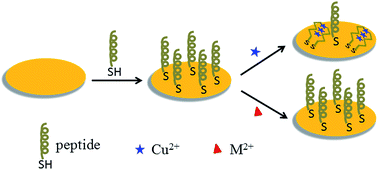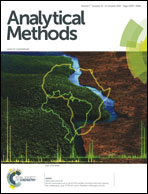Sensitive detection of copper(ii) ions based on the conformational change of peptides by surface plasmon resonance spectroscopy†
Abstract
Due to the significant role of copper(II) ions in many biochemical and physiological processes, sensitive detection of copper(II) ions has attracted great attention. A novel quantitative copper(II) ion sensor is developed based on the conformational change of Cu2+ binding peptides using surface plasmon resonance (SPR) spectroscopy. The specific interaction between carboxyl groups of the peptide and Cu2+ induces a conformational change from α-helix to β-sheet with decreasing hydrophilicity. The formation of Cu2+–peptide aggregates on the chip surface leads to a refractive index change, which results in a sensitive SPR signal change. Thus, Cu2+ can be measured selectively and sensitively due to the conformational change of Cu2+ specific binding peptides. With this well-designed sensing platform, the detection range of copper(II) ions is found to be 1 × 10−12 M to 1 × 10−6 M with a detection limit of 0.44 pM, which is 3 orders of magnitude lower than that in previous reports. The copper(II) ion sensor designed in this study is proposed for application in biological and environmental analysis.


 Please wait while we load your content...
Please wait while we load your content...